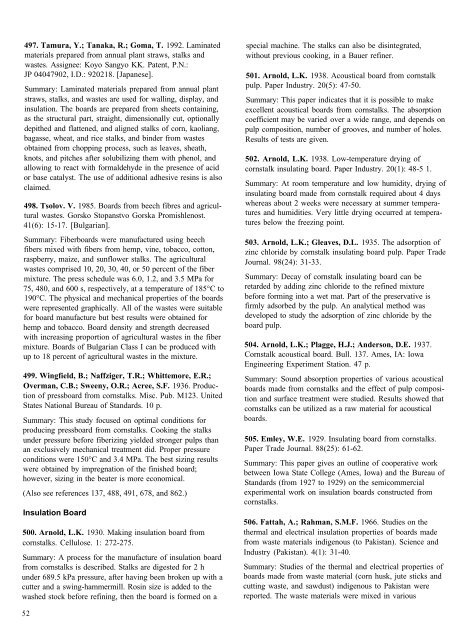Literature Review on Use of Nonwood Plant Fibers for Building ...
Literature Review on Use of Nonwood Plant Fibers for Building ...
Literature Review on Use of Nonwood Plant Fibers for Building ...
Create successful ePaper yourself
Turn your PDF publications into a flip-book with our unique Google optimized e-Paper software.
497. Tamura, Y.; Tanaka, R.; Goma, T. 1992. Laminated<br />
materials prepared from annual plant straws, stalks and<br />
wastes. Assignee: Koyo Sangyo KK. Patent, P.N.:<br />
JP 04047902, I.D.: 920218. [Japanese].<br />
Summary: Laminated materials prepared from annual plant<br />
straws, stalks, and wastes are used <strong>for</strong> walling, display, and<br />
insulati<strong>on</strong>. The boards are prepared from sheets c<strong>on</strong>taining,<br />
as the structural part, straight, dimensi<strong>on</strong>ally cut, opti<strong>on</strong>ally<br />
depithed and flattened, and aligned stalks <strong>of</strong> corn, kaoliang,<br />
bagasse, wheat, and rice stalks, and binder from wastes<br />
obtained from chopping process, such as leaves, sheath,<br />
knots, and pitches after solubilizing them with phenol, and<br />
allowing to react with <strong>for</strong>maldehyde in the presence <strong>of</strong> acid<br />
or base catalyst. The use <strong>of</strong> additi<strong>on</strong>al adhesive resins is also<br />
claimed.<br />
498. Tsolov. V. 1985. Boards from beech fibres and agricultural<br />
wastes. Gorsko Stopanstvo Gorska Promishlenost.<br />
41(6): 15-17. [Bulgarian].<br />
Summary: Fiberboards were manufactured using beech<br />
fibers mixed with fibers from hemp, vine, tobacco, cott<strong>on</strong>,<br />
raspberry, maize, and sunflower stalks. The agricultural<br />
wastes comprised 10, 20, 30, 40, or 50 percent <strong>of</strong> the fiber<br />
mixture. The press schedule was 6.0, 1.2, and 3.5 MPa <strong>for</strong><br />
75, 480, and 600 s, respectively, at a temperature <strong>of</strong> 185°C to<br />
190°C. The physical and mechanical properties <strong>of</strong> the boards<br />
were represented graphically. All <strong>of</strong> the wastes were suitable<br />
<strong>for</strong> board manufacture but best results were obtained <strong>for</strong><br />
hemp and tobacco. Board density and strength decreased<br />
with increasing proporti<strong>on</strong> <strong>of</strong> agricultural wastes in the fiber<br />
mixture. Boards <strong>of</strong> Bulgarian Class I can be produced with<br />
up to 18 percent <strong>of</strong> agricultural wastes in the mixture.<br />
499. Wingfield, B.; Naffziger, T.R.; Whittemore, E.R.;<br />
Overman, C.B.; Sweeny, O.R.; Acree, S.F. 1936. Producti<strong>on</strong><br />
<strong>of</strong> pressboard from cornstalks. Misc. Pub. M123. United<br />
States Nati<strong>on</strong>al Bureau <strong>of</strong> Standards. 10 p.<br />
Summary: This study focused <strong>on</strong> optimal c<strong>on</strong>diti<strong>on</strong>s <strong>for</strong><br />
producing pressboard from cornstalks. Cooking the stalks<br />
under pressure be<strong>for</strong>e fiberizing yielded str<strong>on</strong>ger pulps than<br />
an exclusively mechanical treatment did. Proper pressure<br />
c<strong>on</strong>diti<strong>on</strong>s were 150°C and 3.4 MPa. The best sizing results<br />
were obtained by impregnati<strong>on</strong> <strong>of</strong> the finished board;<br />
however, sizing in the beater is more ec<strong>on</strong>omical.<br />
(Also see references 137, 488, 491, 678, and 862.)<br />
Insulati<strong>on</strong> Board<br />
500. Arnold, L.K. 1930. Making insulati<strong>on</strong> board from<br />
cornstalks. Cellulose. 1: 272-275.<br />
Summary: A process <strong>for</strong> the manufacture <strong>of</strong> insulati<strong>on</strong> board<br />
from cornstalks is described. Stalks are digested <strong>for</strong> 2 h<br />
under 689.5 kPa pressure, after having been broken up with a<br />
cutter and a swing-hammermill. Rosin size is added to the<br />
washed stock be<strong>for</strong>e refining, then the board is <strong>for</strong>med <strong>on</strong> a<br />
52<br />
special machine. The stalks can also be disintegrated,<br />
without previous cooking, in a Bauer refiner.<br />
501. Arnold, L.K. 1938. Acoustical board from cornstalk<br />
pulp. Paper Industry. 20(5): 47-50.<br />
Summary: This paper indicates that it is possible to make<br />
excellent acoustical boards from cornstalks. The absorpti<strong>on</strong><br />
coefficient may be varied over a wide range, and depends <strong>on</strong><br />
pulp compositi<strong>on</strong>, number <strong>of</strong> grooves, and number <strong>of</strong> holes.<br />
Results <strong>of</strong> tests are given.<br />
502. Arnold, L.K. 1938. Low-temperature drying <strong>of</strong><br />
cornstalk insulating board. Paper Industry. 20(1): 48-5 1.<br />
Summary: At room temperature and low humidity, drying <strong>of</strong><br />
insulating board made from cornstalk required about 4 days<br />
whereas about 2 weeks were necessary at summer temperatures<br />
and humidities. Very little drying occurred at temperatures<br />
below the freezing point.<br />
503. Arnold, L.K.; Gleaves, D.L. 1935. The adsorpti<strong>on</strong> <strong>of</strong><br />
zinc chloride by cornstalk insulating board pulp. Paper Trade<br />
Journal. 98(24): 31-33.<br />
Summary: Decay <strong>of</strong> cornstalk insulating board can be<br />
retarded by adding zinc chloride to the refined mixture<br />
be<strong>for</strong>e <strong>for</strong>ming into a wet mat. Part <strong>of</strong> the preservative is<br />
firmly adsorbed by the pulp. An analytical method was<br />
developed to study the adsorpti<strong>on</strong> <strong>of</strong> zinc chloride by the<br />
board pulp.<br />
504. Arnold, L.K.; Plagge, H.J.; Anders<strong>on</strong>, D.E. 1937.<br />
Cornstalk acoustical board. Bull. 137. Ames, IA: Iowa<br />
Engineering Experiment Stati<strong>on</strong>. 47 p.<br />
Summary: Sound absorpti<strong>on</strong> properties <strong>of</strong> various acoustical<br />
boards made from cornstalks and the effect <strong>of</strong> pulp compositi<strong>on</strong><br />
and surface treatment were studied. Results showed that<br />
cornstalks can be utilized as a raw material <strong>for</strong> acoustical<br />
boards.<br />
505. Emley, W.E. 1929. Insulating board from cornstalks.<br />
Paper Trade Journal. 88(25): 61-62.<br />
Summary: This paper gives an outline <strong>of</strong> cooperative work<br />
between Iowa State College (Ames, Iowa) and the Bureau <strong>of</strong><br />
Standards (from 1927 to 1929) <strong>on</strong> the semicommercial<br />
experimental work <strong>on</strong> insulati<strong>on</strong> boards c<strong>on</strong>structed from<br />
cornstalks.<br />
506. Fattah, A.; Rahman, S.M.F. 1966. Studies <strong>on</strong> the<br />
thermal and electrical insulati<strong>on</strong> properties <strong>of</strong> boards made<br />
from waste materials indigenous (to Pakistan). Science and<br />
Industry (Pakistan). 4(1): 31-40.<br />
Summary: Studies <strong>of</strong> the thermal and electrical properties <strong>of</strong><br />
boards made from waste material (corn husk, jute sticks and<br />
cutting waste, and sawdust) indigenous to Pakistan were<br />
reported. The waste materials were mixed in various

















